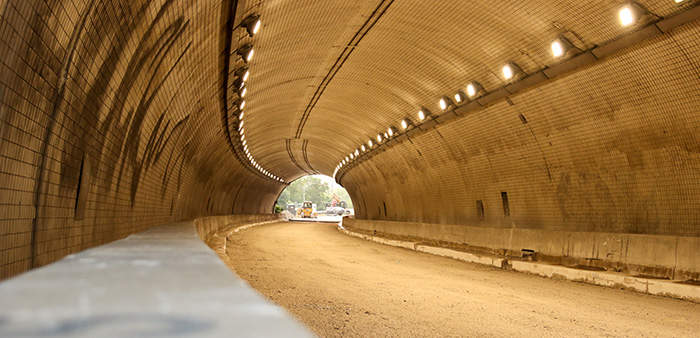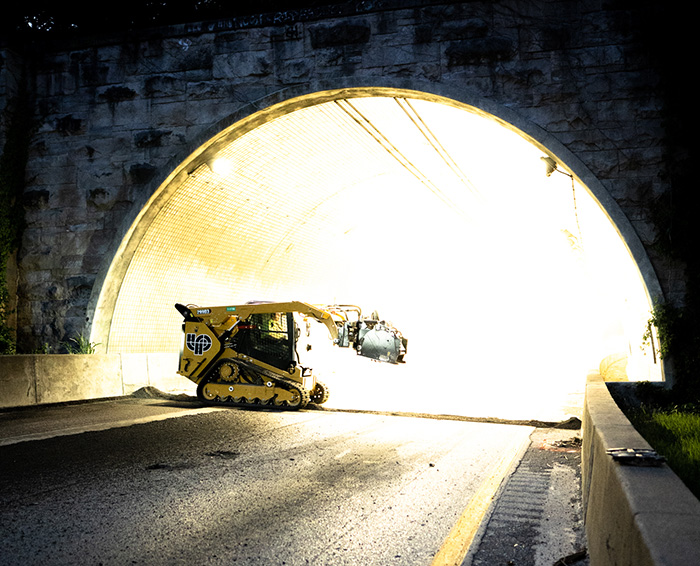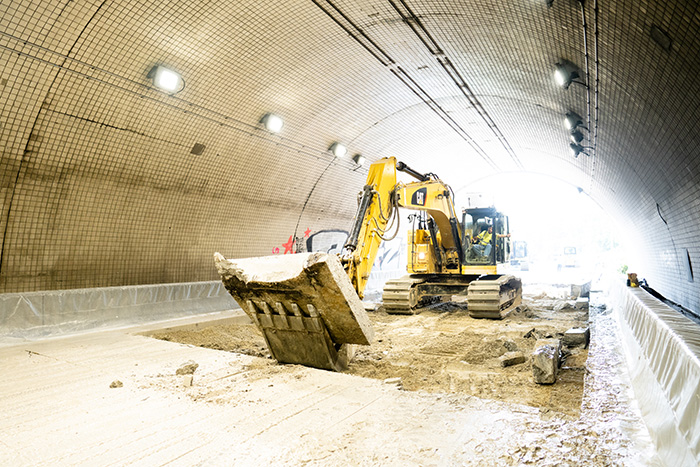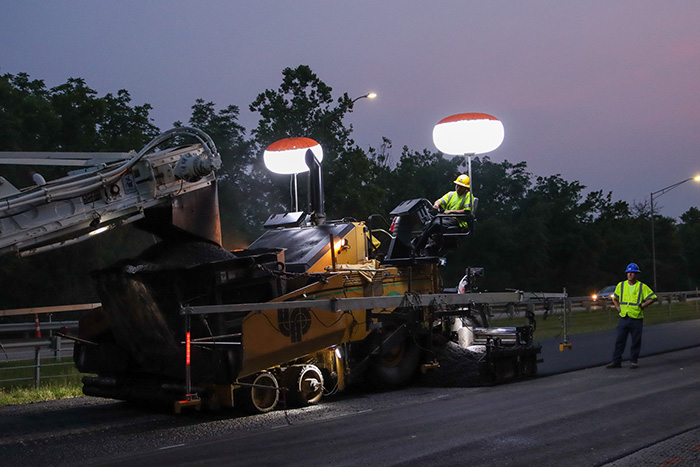The rehabilitation of I-64 and the Cochran Hill Tunnel
By Jason Wielinski, P.E.
Tunnels are transportation engineering marvels in a sense. They have been part of infrastructure development since the time of the Roman Empire. The first transportation tunnel in the United States was the Union Canal tunnel near Lebanon, Pennsylvania, which connected the resource-rich Pennsylvania interior facilitating the delivery of timber and other goods east to Philadelphia. Construction of this tunnel began during the Washington administration.
The first vehicular tunnel in the U.S. was the famous Holland tunnel (opened in 1927), connecting New Jersey and New York under the Hudson River to accommodate the increasing traffic demand. Tunnels pass through mountains, difficult terrain and waterways making a complex passage around or over, easier. They enable our movement through and around these challenges and obstacles.
In the spring of 2023, the Kentucky Transportation Cabinet (KYTC) faced a diverse set of challenges and obstacles when it was time to rehabilitate a stretch of I-64 east of Louisville. This stretch of interstate in Jefferson County between I-264 and Story Avenue was scheduled for pavement resurfacing. This was not, however, a typical mill and fill type project. The scope of the work not only included 22,000 tons of asphalt milling and 25,300 tons of asphalt paving, but it also included joint replacements of nine bridges, a latex bridge deck overlay and 23,500 feet of guardrail replacement. Most interesting and challenging, the project called for 2,800 square yards of concrete pavement removal of the Cochran Hill tunnel floor and replacement with full-depth asphalt.
Cochran Hill Tunnel: Preserving Cherokee Park
Cherokee Park opened in 1891. Frederick Law Olmstead, a renowned landscape architect whose body of work includes the design of New York’s Central Park and the country’s first state park in Niagara Falls, New York designed Cherokee Park. As Jennifer Van Vactor, Director of Marketing with Louisville Paving and Construction (LPC), describes it, “Cherokee Park and the Olmstead Park Conservatory are a local treasure that is situated in a revered historic district of Louisville.”
The goal was to preserve Cherokee Park and minimize the impact of the highway through the surrounding ecosystem when planning I-64. The twin tunnels originally opened in 1970 at a cost of 1.9 million dollars. The tunnel itself is significant as it is the second longest tunnel in Kentucky’s interstate system and is officially recognized as an “exceptionally significant” structure by the Federal Highway Administration for “the development of environmentally sensitive design in the area of transportation engineering.”
Today, the tunnel continues to carry traffic beneath the park recognized by the National Register of Historic Places.
Using financial, human and environmental resources economically
Time is money. The relationship of time and money played an integral role in the execution and success of the I-64 rehabilitation. The project letting date was March 23, 2023, with a completion date of August 31, 2023. The total contract amount was $13.2 million for the scope of work and was awarded to LPC. The project had multiple phases. The first phase involved nightly closures to address bridge work, guardrail removal and ditching and shoulder work across the entire project. The next two phases called for one 10-day closure in the Eastbound I-64 lanes and then one 10-day closure in the I-64 Westbound lanes to complete the mainline and tunnel work. These eventually were changed to 14 days for each side after additional work was identified. Both closures had to be completed in a window between June 1 and July 31. Let’s just say the contractor had the distinct motivation to complete these phases as liquidated damages at $50,000 per hour or $1,200,000 per day were to be assessed if the project ran over the specified closures or if the closures were not completed by July 31.
As with any project, there are always obstacles that arise once the work begins. Brian Bierman, Vice President with LPC, reported that the cross-section of the tunnel floor was inconsistent, ranging from 10 to 19 inches in depth. This required more sawing, hauling away of material, aggregate base, and time. In addition to the tunnel floor removal, work on the project adjacent to the tunnel including milling, bridge joint installation, guardrail painting and final bridge wall installation had to be completed prior to mainline paving. Aggregate base installation was required prior to constructing the full-depth asphalt pavement in the tunnel, as shown in the typical plans. Bierman also noted that in the eastbound closure, the bridge treatment over Lexington Road changed from a few patches to a full latex overlay. This also posed additional time constraints as paving was delayed to account for the extended cure times.
“The project schedule included a substantial amount of work to be completed within a limited timeframe, given the traffic control plan of closing one direction at a time to expedite the project with the least amount of traffic impacts. There was uncertainty about what Louisville Paving would encounter when uncovering the roadway substructure, given that the area had not been excavated since the tunnels were constructed,” said KYTC Project Manager Chris Slone.
Achieving the engineering goals
It is critical that a project with this amount of complexity and significance will need to perform long term to meet the engineering goals for which it had been designed and constructed. Landon Blume, Senior Project Manager with LPC shared that multiple best practices and innovative technologies were used to construct a quality long-lasting asphalt pavement including:
• Echelon Paving: LPC performed echelon paving on this project to eliminate any cold longitudinal construction joints. Echelon paving is where adjacent lanes are built side-by-side at the same time with multiple pavers. The longitudinal joint between these two passes is compacted when the mix is still hot. Experience has shown that hot-compacted longitudinal joints typically have better long-term performance compared to conventional cold-compacted joints. Echelon paving could be used because of the full closures on each pavement direction.
• Infrared temperature collection: Blume also shared that KYTC performed infrared temperature monitoring on the project. Infrared temperature monitoring measures and records the surface temperature of the mixtures as it is placed. This enables the contractor to make corrective action if thermal segregation is observed from the real-time data collection. This temperature monitoring ensures adequate and consistent mat temperatures, helps with density, smoothness and long-term performance.
• Innovative Materials: Bierman shared that the KYTC specifications on the project included fibers in all layers of the mix placed in the tunnel for enhanced mix performance.
• Quality and Density: It is well documented that sufficient, consistent mat density and performance are directly correlated. The project specified KYTC Option A for acceptance which includes both density and smoothness.
• Smoothness: Smooth roads stay smooth longer. KYTC Category A requirements for rideability specifies that the contractor achieves an International Roughness Index (IRI) of less than 70 for each 0.1-mile section.
Preserving the surrounding ecosystems
The original construction of the Cochran Hill Tunnel preserved Cherokee Park and maintained the character and landscape in the area. It was also paramount to the overall project success to maintain and restore the appearance of the tunnel itself. The tunnel is adorned with historic tiles that Blume described as irreplaceable.
“We had 15-foot clearance of the outside edges of the tunnel ceiling and 26-foot clearance in the middle. Loading trucks during concrete floor removal with that tight clearance meant spotters were always used. Raising truck beds to deliver mix into the shuttle buggy also required a spotter. We had to be sure not to damage the ceiling and tiles,” said Bierman.
A social consideration of the project was the aesthetic requirements. The slightly longer lane closures enabled KYTC to remove unsightly street art that marred the inside tunnel walls. Ensuring the most pleasing appearance of the 23,500 feet of replaced guardrail was also a project priority. The guardrail was painted with a specific manufacturer and color to blend in seamlessly with the surrounding park environment.
Meeting humans needs such as safety
Both Bierman and Blume emphasized the importance of communication to ensure safety to all working onsite and for the traveling public. The LPC team had to coordinate over 120 people at the start of each 10-day closure. A combination of fifty tri-axle dump trucks and four milling machines were on site supporting the expedition milling and preparation of I-64 for mainline paving. Not to mention, there were other projects operations ongoing during the closures, including bridge joint repairs, and bridge deck work. Just like a conductor leading an orchestra, all facets of the project had to operate in harmony. Bierman stressed that keeping all teammates safe and getting them to where they needed to be all while mobilizing equipment to the site was the main priority of the project.
There was also the challenge of keeping the traveling public safe in and around the project limits and most importantly, out of the work area. The team had to coordinate the closure of over ten access points to I-64 yet maintain safe access and egress points for construction equipment cycling material in and out of the job site. Ensuring proper signage, closures and detours for traffic demanded thorough planning and communication. Blume added that the location of the project and surrounding infrastructure around the east side of Louisville made it convenient to reroute through traffic around the project limits. He stated there were no long queues of traffic within the project.
The result
The light at end of the tunnel approached quickly and persistently on this project. Through increased communication and planning with KYTC, subcontractors and the crews the LPC team prevailed. Using two crews working around the clock, both closures were completed within the allowed period and zero liquidated damage was assessed on the project. LPC completed the west-bound lane closure in eight days and tackled the east-bound closure under the 14-day allowable window. LPC laid over twenty-seven thousand tons of asphalt mixture in only ten days out of a single plant. The team overcame the challenges and obstacles with time and coordination, with the help of weather and zero plant breakdowns.
The trade-off of high pressure, time constraint full lane closure versus typical construction projects under traffic was significant. Blume estimated under normal maintenance of traffic conditions, the project could have taken over six months to complete. With full lane closures, the contractor completed the mainline project portion in 22 days. This had a significant positive impact to the driving public in not only reducing the duration of user delays, but also creating a safer work zone for all involved.
As for performance, Blume and Bieman reported that quality control bonuses were achieved across the entire project. Bierman also reported that the IRI rideability results across the project were 49.1 in/mi., a noticeable improvement to the ride prior to rehabilitation. The balance between production and quality was not compromised and the new asphalt pavement on I-64 and through the Cochran Hill tunnel should provide a smooth durable ride for years to come.
The most positive and rewarding report for this project is the safety component. Despite the significant amount of equipment, various operations and the sheer number of crew teammates involved, Bierman proclaimed that there was not one injury reported on this project with over 18,657 man-hours worked. This is an excellent example to be recognized and celebrated of taking care of people.
The tunnel through Cochran Hill endures to preserve the significance of Cherokee Park above but it now enables passage on a smooth, quality asphalt pavement.
Wielinski is an Asphalt Institute Regional Engineer based in Ohio.
















